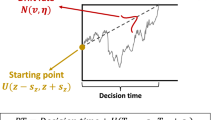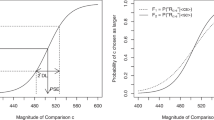Abstract
Identification accuracy for sets of perceptually discriminable stimuli ordered on a single dimension (e.g., line length) is remarkably low, indicating a fundamental limit on information processing capacity. This surprising limit has naturally led to a focus on measuring and modeling choice probability in absolute identification research. We show that choice response time (RT) results can enrich our understanding of absolute identification by investigating dissociation between RT and accuracy as a function of stimulus spacing. The dissociation is predicted by the SAMBA model of absolute identification (Brown, Marley, Dockin, & Heathcote, 2008), but cannot easily be accommodated by other theories. We show that SAMBA provides an accurate, parameter free, account of the dissociation that emerges from the architecture of the model and the physical attributes of the stimuli, rather than through numerical adjustment. This violation of the pervasive monotonic relationship between RT and accuracy has implications for model development, which are discussed.



Similar content being viewed by others
Notes
It is elementary to show that responses j and j + 1 have equal response strengths at the point that is midway between the long term referents for stimuli j and j + 1, and this holds for both equally spaced and unequally spaced stimulus sets.
References
Ashby, F. G. (2000). A stochastic version of general recognition theory. Journal of Mathematical Psychology, 44, 310–329.
Ashby, F. G., & Lee, W. W. (1991). Predicting similarity and categorization from identification. Journal of Experimental Psychology: General, 120, 150–172.
Brown, S., & Heathcote, A. (2005). A ballistic model of choice response time. Psychological Review, 112(1), 117–128.
Brown, S. D., & Heathcote, A. (2008). The simplest complete model of choice reaction time: linear ballistic accumulation. Cognitive Psychology.
Brown, S., Marley, A. A. J., Donkin, C., & Heathcote, A. (2008). An integrated architecture for absolute identification. Psychological Review, 115, 396–425.
Donkin, C., Dodds, P., Brown, S. D., & Heathcote, A. (2008). Revisiting the Limits of Human Information Processing Capacity. (submitted).
Duyck, W., Lagrou, E., Gevers, W., & Fias, W. (2008). Roman digit naming: evidence for a semantic route. Experimental Psychology, 55, 73–81.
Kane, M. J., & Engle, R. W. (2003). Working-memory capacity and the control of attention: The contributions of goal neglect, response competition, and task set to stroop interference. Journal of Experimental Psychology, 132, 47–70.
Karpiuk, P., Jr., Lacouture, Y., & Marley, A. A. J. (1997). A limited capacity, wave equality, random walk model of absolute identification. In A. A. J. Marley (Ed.), Choice, decision and measurement: essays in honour of R. Duncan Luce (pp. 279–299). Mahwah: Erlbaum.
Kent, C., & Lamberts, L. (2005). An exemplar account of the bow and set size effects in absolute identification. Journal of Experimental Psychology: Learning, Memory, and Cognition, 31, 289–305.
Lacouture, Y. (1997). Bow, range, and sequential effects in absolute identification: a response-time analysis. Psychological Research, 60, 121–133.
Lacouture, Y., & Marley, A. A. J. (1995). A mapping model of bow effects in absolute identification. Journal of Mathematical Psychology, 39, 383–395.
Lacouture, Y., & Marley, A. A. J. (2004). Choice and response time processes in the identification and categorization of unidimensional stimuli. Perception & Psychophysics, 66, 1206–1226.
Lamberts, K. (2000). Information-accumulation theory of speeded categorization. Psychological Review, 107, 227–260.
Lockhead, G. R. (2004). Absolute judgments are relative: a reinterpretation of some psychophysical ideas. Review of General Psychology, 8, 265–272.
Lockhead, G. R., & Hinson, J. (1986). Range and sequence effects in judgment. Perception & Psychophysics, 40, 53–61.
Luce, R. D., Nosofsky, R. M., Green, D. M., & Smith, A. F. (1982). The bow and sequential effects in absolute identification. Perception & Psychophysics, 32, 397–408.
Marley, A. A. J., & Cook, V. T. (1984). A fixed rehearsal capacity interpretation of limits on absolute identification performance. British Journal of Mathematical and Statistical Psychology, 37, 136–151.
Marley, A. A. J., & Cook, V. T. (1986). A limited capacity rehearsal model for psychological judgments applied to magnitude estimation. Journal of Mathematical Psychology, 30, 339–390.
Miller, G. A. (1956). The magical number seven, plus or minus two: Some limits on our capacity for information processing. Psychological Review, 63, 81–97.
Nosofsky, R. M. (1997). An exemplar-based random-walk model of speeded categorization and absolute judgment. In A. A. J. Marley (Ed.), Choice, decision and measurement: essays in honor of R. Duncan Luce (pp. 347–365). Mahwah: Erlbaum.
Nosofsky, R. M., & Palmeri, T. J. (1997). An exemplar-based random walk model of speeded categorization. Psychological Review, 104, 266–300.
Petrov, A. A., & Anderson, J. R. (2005). The dynamics of scaling: a memory-based anchor model of category rating and absolute identification. Psychological Review, 112, 383–416.
Ratcliff, R. (1978). A theory of memory retrieval. Psychological Review, 85, 59–108.
Roeflofs, A. (2006). Functional architecture of naming dice, digits, and number words. Language and Cognitive Processes, 21, 78–111.
Rouder, J. N., Morey, R. D., Cowan, N., & Pfaltz, M. (2004). Learning in a unidimensional absolute identification task. Psychonomic Bulletin & Review, 11, 938–944.
Stewart, N., Brown, G. D. A., & Chater, N. (2005). Absolute identification by relative judgment. Psychological Review, 112, 881–911.
Wuehr, P., & Frings, C. (2008). A Case for Inhibition: visual attention suppresses the processing of irrelevant objects. Journal of Experimental Psychology: General, 137, 116–130.
Author information
Authors and Affiliations
Corresponding author
Appendix: The latencies of incorrect responses
Appendix: The latencies of incorrect responses
The relative speeds of correct and incorrect responses have proven very illuminating in the development of theories of choice response time (see, e.g., Brown & Heathcote, 2005, 2008). Theoretical accounts of response times in absolute identification are less well developed, so the fine model discrimination afforded by the analysis of error RT may yet be premature. Nevertheless, we note here two interesting phenomena related to incorrect RTs in Lacouture’s (1997) data. Firstly, response times were slightly, but reliably, slower for incorrect responses than correct responses in the unequal spacing conditions of Lacouture’s experiment (mean difference 29 ms, t(38) = 2.5, p < 0.01). Secondly, the relative speed of correct and incorrect responses changed systematically with stimulus magnitude. For extreme stimuli (#1 and #10), incorrect responses were much slower than correct responses (mean difference 269 ms, t(46) = 7.5, p < 0.001) but for central stimuli (#5 and #6) there was almost no difference (mean difference 10 ms, t(46) = 0.3, p > 0.05). The relative speeds of correct and incorrect responses are captured well by SAMBA—a brief illustration, Fig. 4 shows mean error response times along with SAMBA’s predictions using the same format as Fig. 2. The model captures the global qualitative trends in the data, but misses some of the finer quantitative properties, such as the tendency for some extreme responses to be associated with very fast errors (e.g., #1 in C-L condition and #10 in E-S and C-S). It also fails to capture a tendency for participants in the central gap conditions (C–L and C–S) to make fast errors when responding with #5. The reader might suppose that these faster errors are due to stimulus #5 lying adjacent to a gap. However, this does not explain why the same pattern is not shown for response #6 or in the E–L or E–S conditions.
We do not take the observed goodness of fit to be as impressive as SAMBA’s ability to fit our main focus, the effects of stimulus spacing. Although the patterns of fast and slow errors may appear complex at first glance, they are less theoretically challenging than might be imagined. For example, incorrect response times were slower than correct response times, as predicted by SAMBA. Other models of absolute identification do not predict this in their current forms. For example, Kent and Lamberts’ (2005) model uses a random walk, which is constrained to predict equal response times for correct and incorrect responses (see e.g., Ratcliff, 1978). However, this limitation is not central to Kent and Lamberts’ model, and can easily be remedied by the addition of certain variance components to its decision phase (as described by Ratcliff). Similarly, any model of absolute identification that predicts the ubiquitous bow effects—longer RT for central responses and shorter RT for extreme responses—will necessarily produce slower mean error than correct RTs for extreme stimuli. This is because those incorrect responses are less extreme (usually #2 and #9, rather than #1 and #10, for example) and hence slower due to the bow effect. For these reasons, we think that a detailed comparison of empirical results with theoretical predictions for incorrect response times may be premature for models of absolute identification.
Rights and permissions
About this article
Cite this article
Donkin, C., Brown, S.D., Heathcote, A. et al. Dissociating speed and accuracy in absolute identification: the effect of unequal stimulus spacing. Psychological Research 73, 308–316 (2009). https://doi.org/10.1007/s00426-008-0158-2
Received:
Accepted:
Published:
Issue Date:
DOI: https://doi.org/10.1007/s00426-008-0158-2





